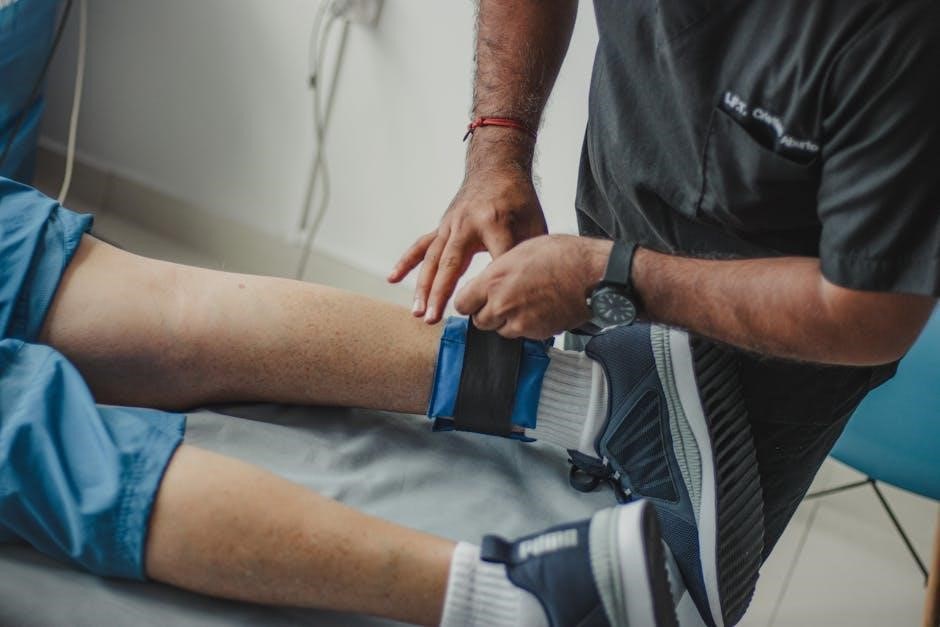ITBS is a common overuse injury causing pain on the outer thigh and knee due to friction between the IT band and femur. It’s prevalent in runners and cyclists, often due to repetitive knee motion. Stretching and strengthening exercises are key to managing symptoms and preventing recurrence.
Brief Overview of ITBS
Iliotibial Band Syndrome (ITBS) is a common overuse injury characterized by pain along the outer thigh and knee. It occurs when the IT band, a thick fibrous tissue running from the hip to the knee, becomes inflamed or irritated due to repetitive friction. ITBS is prevalent among runners, cyclists, and individuals engaging in activities involving repetitive knee flexion. Symptoms include sharp or dull pain on the outside of the knee, especially during movement. Proper stretching and strengthening exercises are essential for managing ITBS and preventing recurrence. Early intervention can help alleviate symptoms and restore normal activity levels, making it a critical area of focus for both athletes and non-athletes alike.
Importance of Stretches in Managing ITBS
Stretches play a crucial role in managing ITBS by reducing tension in the IT band and improving flexibility. Regular stretching helps alleviate pain and inflammation, preventing further irritation. It targets both the IT band and surrounding muscles, promoting proper alignment and movement. Stretching exercises, such as standing IT band stretches and wall-assisted techniques, are effective in increasing flexibility and reducing discomfort. Incorporating these stretches into a daily routine can significantly enhance recovery and prevent recurrence. By addressing tightness and improving range of motion, stretches contribute to long-term management of ITBS, allowing individuals to resume their normal activities without pain. Consistency is key to achieving lasting benefits.
Causes and Risk Factors of ITBS
ITBS arises from repetitive knee flexion, leading to friction and inflammation of the IT band. Risk factors include tight IT bands, muscle imbalances, and overuse in activities like running or cycling.
Repetitive Knee Motion and Its Impact
Repetitive knee motion is a primary contributor to ITBS, particularly in activities like running or cycling. This repeated flexion and extension cause the IT band to rub against the femur, leading to friction and inflammation. Over time, this friction can irritate the surrounding tissues, including the bursa, resulting in pain and swelling on the outside of the knee. Activities that involve downhill running or sudden increases in training intensity exacerbate this issue, as they place additional stress on the IT band. Proper warm-up routines, consistent stretching, and strengthening exercises can help mitigate the risks associated with repetitive knee motion and reduce the likelihood of developing ITBS.
Anatomical Structure and Function of the IT Band
The IT band, or iliotibial band, is a thick, fibrous fascia that runs along the outer thigh, originating from the ilium and tensor fasciae latae muscle. It extends down to the lateral tibia, just below the knee. This structure plays a crucial role in stabilizing the knee during movements like walking or running. The IT band helps to control leg alignment and assists in hip abduction and knee flexion. Its tightness or improper alignment can lead to friction against the femur, contributing to ITBS. Understanding its anatomical structure is essential for developing effective stretching and strengthening exercises to manage symptoms and improve mobility. Proper care of the IT band is vital for maintaining functional movement and preventing overuse injuries.
Muscle Imbalances Contributing to ITBS
Muscle imbalances, particularly in the hips and glutes, are significant contributors to ITBS. Weakness in the gluteus medius and minimus muscles can lead to poor hip stabilization, causing the IT band to compensate and become overactive. This compensation often results in increased tension and friction along the IT band, especially during repetitive movements like running or cycling. Additionally, tightness in the tensor fasciae latae (TFL) muscle, which connects to the IT band, can exacerbate the issue. Strengthening the glutes and improving flexibility in the TFL and IT band are essential for restoring balance and reducing the risk of ITBS. Addressing these imbalances through targeted exercises can help alleviate symptoms and prevent recurrence. Regular stretching and strengthening routines are crucial for maintaining proper muscle function and overall lower limb alignment.

Symptoms and Diagnosis of ITBS
ITBS typically presents with sharp pain on the outer thigh or knee, worsening during activities like running or cycling. Swelling and tenderness near the knee are common. Diagnosis involves clinical exams, such as the Noble’s test, and imaging to rule out other conditions.
Identifying Pain Locations and Characteristics
The pain from ITBS is typically localized to the lateral (outer) aspect of the thigh and knee. It often presents as a sharp, stabbing sensation that worsens during activities like running, cycling, or descending stairs. The discomfort may radiate along the IT band, from the hip to the knee, and is usually more pronounced when the knee is flexed at around 30 degrees. Swelling or redness is uncommon, but tenderness to the touch along the IT band is a common finding. Pain may also be accompanied by a snapping or popping sensation near the knee joint due to the IT band’s irritation. Accurate identification of these pain characteristics is crucial for proper diagnosis and treatment.
Clinical Exams and Diagnostic Tests for ITBS
Diagnosing ITBS involves a combination of clinical examinations and diagnostic tests. Physicians typically perform a physical exam to assess tenderness along the IT band, particularly over the lateral femoral condyle. The Ober test is commonly used to evaluate tightness or inflammation of the IT band, while the Renne test can detect friction as the knee flexes. Imaging studies, such as X-rays or MRIs, are usually not required unless other conditions like fractures or ligament injuries are suspected. Palpation of the affected area and observation of pain during specific movements, like bending or straightening the knee, are key diagnostic tools. These assessments help differentiate ITBS from other causes of knee pain, ensuring an accurate diagnosis.

Prevention Strategies for ITBS
Preventing ITBS involves strengthening exercises, proper training techniques, and equipment checks. Gradually increasing activity intensity and avoiding repetitive motions can reduce the risk of developing ITBS.
Strengthening Exercises to Prevent ITBS
Strengthening the glutes and core is crucial for ITBS prevention, as weak muscles can lead to poor movement patterns and increased IT band tension. Exercises like glute bridges, side-lying leg lifts, and clamshells target the gluteus medius and minimus, which help stabilize the pelvis during movement. Additionally, incorporating hip abductor and external rotator exercises can improve lower limb alignment and reduce friction on the IT band. Strengthening programs should be done 2-3 times weekly, focusing on controlled movements and proper form. These exercises not only prevent ITBS but also enhance overall athletic performance and reduce injury risk. Consistency and progression are key to long-term benefits.
Proper Training Techniques to Avoid Injury
Proper training techniques are essential for preventing ITBS, focusing on avoiding repetitive stress and poor biomechanics. Avoid excessive downhill running or cycling, as these activities can increase IT band friction. Gradually increase training intensity and mileage to allow tissues to adapt. Incorporate rest days and cross-training to reduce repetitive knee motion. Ensure proper footwear and equipment to maintain optimal lower limb alignment. Strengthening and stretching programs should be integrated into daily routines. Pay attention to running or cycling mechanics, such as maintaining a midfoot strike and avoiding overstriding. Consistent training schedules and biomechanical assessments can help identify and address issues before they lead to injury. Proper technique reduces the risk of ITBS and enhances overall performance.
Effective stretches for ITBS target the IT band and surrounding muscles, improving flexibility and reducing friction. Regular stretching helps alleviate symptoms and prevent recurrence. The standing IT band stretch is a simple yet effective exercise to improve flexibility. Stand near a stable object for balance, cross the affected leg behind the other, and bend the front knee slightly. Lean toward the unaffected side until a mild stretch is felt on the outer thigh. Hold for 15-30 seconds and repeat 2-3 times on each side. This stretch targets the IT band, reducing tension and friction. Regular practice can help alleviate pain and prevent ITBS symptoms. Proper form ensures maximum benefit and minimizes injury risk. The wall-assisted IT band stretch is an effective way to improve flexibility and reduce tension. Stand a few inches from a wall with your affected hip closest to it. Bend your knee slightly and let your hip drop outward against the wall. Lean away from the affected side until you feel a gentle stretch along the outer thigh. Hold for 15-30 seconds, then repeat 2-3 times. This stretch targets the IT band, reducing friction and alleviating pain. Perform it 2-3 times daily for optimal results. Proper form ensures a safe and effective stretch, helping to manage ITBS symptoms and enhance mobility. Consistency is key for long-term benefits; The foam roller stretch provides effective IT band release by reducing tension and improving circulation. Lie on your side with the foam roller under the affected leg, just below the hip. Support your body with your hands and cross your unaffected leg in front for balance. Slowly roll the foam roller along the IT band from the hip to the knee, focusing on tender areas. Spend 20-30 seconds on each spot, breathing deeply to relax the muscle. Repeat for 2-3 sets, 2-3 times daily. This technique helps alleviate tightness and friction, promoting recovery and preventing ITBS recurrence. Regular use enhances flexibility and reduces discomfort during physical activities. Consistency is crucial for optimal results.
Effective treatment involves rest, ice, and anti-inflammatory medications to reduce acute symptoms. Physical therapy, stretching, and strengthening exercises also play a crucial role in recovery and prevention. Rest and ice therapy are essential for managing acute ITBS symptoms. Immediate rest prevents further irritation of the IT band, while ice reduces inflammation and pain. Apply ice packs to the affected area for 15-20 minutes, several times a day. Elevation of the leg can also help reduce swelling. Avoid activities that aggravate the condition, such as running or cycling, until symptoms improve. This approach is particularly effective in the initial stages to alleviate pain and inflammation, creating a foundation for recovery. Rest and ice therapy, combined with proper rehabilitation, help restore function and prevent recurrence of ITBS symptoms. Physical therapy plays a crucial role in ITBS recovery by focusing on strengthening and improving flexibility. Exercises often include targeted stretches for the IT band, hamstrings, and hip flexors. Strengthening workouts, such as glute bridges and core exercises, help stabilize the knee and hip. Manual therapy techniques, like soft tissue mobilization, can reduce tightness and promote healing. Additionally, balance and proprioceptive exercises improve overall lower limb stability. These exercises are typically performed under the guidance of a physical therapist to ensure proper form and progression. Consistency in performing these exercises leads to long-term relief and reduces the risk of recurrence, enabling a return to normal activities and sports. Anti-inflammatory medications, such as ibuprofen and naproxen, are commonly used to alleviate pain and reduce swelling in ITBS. These medications target inflammation, which is often the root cause of discomfort. They can be taken orally as directed and are most effective during the acute phase of the injury. Topical creams or gels containing NSAIDs may also provide localized relief. However, long-term use should be avoided due to potential side effects. Always consult a healthcare provider before starting any medication to ensure it aligns with your overall health and treatment plan. These medications complement stretching and physical therapy for comprehensive pain management and recovery. Consult a doctor if pain persists, swelling increases, or mobility is severely limited. Seek medical advice for chronic symptoms or if self-care measures fail to improve condition. Severe pain and swelling along the outer thigh or knee may indicate advanced ITBS. Pain typically worsens with activity and may radiate down the leg; Swelling around the knee or hip can signal inflammation. If pain is unbearable, making weight-bearing activities difficult, or if swelling is significant and persistent, seek immediate medical attention. These symptoms suggest potential tissue damage or underlying conditions needing professional evaluation. Ignoring severe symptoms can lead to prolonged recovery or complications, emphasizing the importance of timely intervention. Early diagnosis ensures appropriate treatment, preventing further deterioration and promoting effective management of the condition. Chronic ITBS symptoms, such as persistent pain and limited mobility, require comprehensive management. If symptoms persist despite home stretches and rest, consulting a healthcare professional is crucial. They may recommend physical therapy to restore strength and flexibility. In severe cases, mobility aids or orthotics might be necessary to reduce strain on the affected area. Addressing muscle imbalances and poor biomechanics is key to preventing recurrence. Chronic symptoms can significantly impact daily activities, making prompt intervention essential to avoid long-term mobility issues and enhance quality of life. A tailored treatment plan ensures effective recovery and returns functionality, allowing individuals to resume normal activities without discomfort or restriction; Advanced techniques include dynamic stretches, foam rolling, and progressive resistance exercises to enhance IT band flexibility and strength. These methods target underlying muscle imbalances and improve mobility. Strengthening the glutes and core muscles is crucial for managing ITBS, as weak hip muscles can lead to poor running or cycling mechanics, increasing IT band tension. Exercises like glute bridges, side-lying leg lifts, and planks target these areas, improving pelvic stability and reducing strain on the IT band. Incorporating these exercises into a daily routine can help alleviate symptoms and prevent recurrence. Consistency is key, as muscle strength takes time to develop. By addressing muscle imbalances, individuals can achieve better overall lower limb alignment and reduce the risk of ITBS flare-ups. Regular practice ensures long-term benefits and enhanced athletic performance. Advanced stretching techniques are essential for enhancing IT band flexibility and reducing tension. Techniques like dynamic stretching, which involve moving through ranges of motion, can be particularly effective. For example, leg swings and lunges with a focus on hip abduction can target the IT band. Additionally, incorporating tools like foam rollers or massage balls can provide deeper tissue release. These methods help break down scar tissue and improve circulation, promoting healing and flexibility. Regular practice of these advanced stretches not only alleviates current symptoms but also serves as a preventive measure against future episodes of ITBS. Consistency is key to achieving long-term flexibility and reducing the risk of injury. Effective management of ITBS requires a combination of stretches, strengthening exercises, and proper training techniques. Downloadable PDF guides provide comprehensive routines and tips for long-term relief and prevention. ITBS is an overuse injury causing lateral thigh and knee pain due to IT band friction. Key management includes rest, ice, and targeted stretches like standing IT band stretches and foam roller exercises. Strengthening glutes and core muscles helps improve stability and reduce recurrence. Proper training techniques, such as avoiding repetitive knee motions, are crucial. Addressing muscle imbalances and incorporating flexibility exercises can prevent long-term issues. Combining these strategies with physical therapy and anti-inflammatory medications provides comprehensive relief. Consulting a healthcare professional is recommended for severe or chronic symptoms. Regular practice of ITBS-specific exercises ensures sustained recovery and prevents future flare-ups. Downloadable PDF guides provide structured routines for managing ITBS through stretches and exercises. These guides often include detailed instructions for standing IT band stretches, wall-assisted stretches, and foam roller techniques. They typically outline the frequency and duration of each exercise, such as 3 sets of 60 seconds, 2-3 times daily. Many PDF resources emphasize proper technique to maximize flexibility and prevent further irritation. Additionally, they may include visual aids like diagrams or photos to guide users through each stretch. These guides are particularly useful for individuals seeking a self-directed approach to managing ITBS symptoms and improving mobility. Regular use of these exercises can help reduce pain and prevent recurrence.
Effective Stretches for ITBS
Standing IT Band Stretch Technique
Wall-Assisted IT Band Stretch for Flexibility
Foam Roller Stretch for IT Band Release

Treatment and Management of ITBS
Rest and Ice Therapy for Acute Symptoms
Physical Therapy Exercises for ITBS Recovery
Anti-Inflammatory Medications for Pain Relief

When to See a Doctor
Recognizing Severe Pain and Swelling
Addressing Chronic Symptoms and Limited Mobility

Advanced Techniques and Exercises
Strengthening Glutes and Core for Stability
Improving Flexibility Through Advanced Stretches
Downloadable PDF Guides for ITBS Stretches

